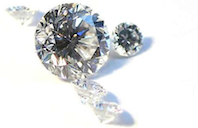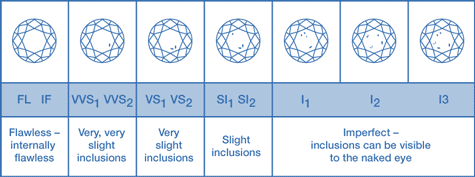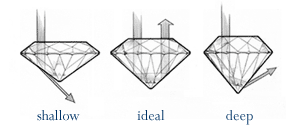Diamond Guide
Diamonds
Each diamond is unique, endowed with a personality and character all its own. A complex blend of subtle characteristics that cannot be imitated. The brilliance, the sparkle, the dance of light and color released from every diamond is the miraculous reflection of the very fires of creation. These characteristics, explained in this diamond guide, come from a diamond’s color, cut and clarity.
Diamonds Are as Hard as They Are Rare
No other natural substance can match the hardness of a diamond which is 2,000 times harder than either rubies or sapphires and 3,000 times harder than man-made imitations such as synthetic cubic zirconia. And, no other gemstone is so hard to find or difficult to mine. Indeed, the larger the diamond, the rarer it is. A three carat diamond, for example, can cost up to seven times more than a one carat diamond of equal color and clarity. Only one polished diamond in a thousand is over one carat.
Why Diamonds Make the Perfect Choice
There are few other gifts in the world that can thrill and delight quite as much as a diamond. When you wear diamonds you’re in brilliant company. For thousands of years diamonds have been the gift choice for those who want to melt a heart and show someone they are truly special. From ancient royalty prizing them for their sparkle to the nervous guy trying to select the perfect engagement ring, nothing else can match a diamond. Diamonds have been sought after for mythical healing, mystical and spiritual properties, but most of all they have for centuries represented the most beautiful and magical gift of love.
Diamond Color
Diamonds are found in almost every color of the rainbow, but white-colored diamonds remain most popular. They are graded on a color scale established by the Gemological Institute of America (GIA) which ranges from D (colorless) to Z. Warmer colored diamonds (K–Z) are particularly desirable when set in yellow gold. Icy winter whites (D–J) look stunning set in white gold or platinum.
Color differences are very subtle and, for example, it is very difficult to see the difference between an E and an F. Therefore, colors are graded under controlled lighting conditions and are compared to a master set for accuracy. Truly colorless stones, graded D, are treasured for their rarity and sit highest on the Diamond Quality Pyramid. Color, however, ultimately comes down to personal taste. Ask you Lake Country Jeweler to show you a variety of color grades next to one another to help you determine your color preference.
If a white diamond is not what you are looking for, nature has also created diamonds in intense shades of blue, green, yellow, orange, pink and, the rarest of all, red. These diamonds are called ‘colored fancies’ and are extremely rare and highly treasured.

Diamond Clarity
![]()
![]() Every diamond is unique. Nature ensures that each diamond is as individual as the person who wears it. Naturally-occurring features, known as inclusions, provide the stone with a special fingerprint. Inclusions are natural identifying characteristics, such as minerals or fractures, developing while diamonds are formed in the earth. They may look like tiny crystals, clouds or feathers.
Every diamond is unique. Nature ensures that each diamond is as individual as the person who wears it. Naturally-occurring features, known as inclusions, provide the stone with a special fingerprint. Inclusions are natural identifying characteristics, such as minerals or fractures, developing while diamonds are formed in the earth. They may look like tiny crystals, clouds or feathers.
Some inclusions are visible to the naked eye. To view other, jewelers use a magnifying loupe. This tool allows jewelers to see a diamond at 10x its actual size so that inclusions are easier to see. The position of inclusions can affect the value of a diamond. There are very few flawless diamonds found in nature, thus these diamonds are much more valuable.
Inclusions are ranked on a scale of perfection, known as clarity, which was established by the Gemological Institute of America (GIA). The clarity scale, ranging from F (Flawless) to Included (I), is based on the visibility of inclusions at a magnification of 10x.
Some inclusions can be hidden by a mounting, thus having little effect on the beauty of a diamond. An inclusion in the middle or top of a diamond could impact the dispersion of light, sometimes making the diamond less brilliant. The greater a diamond’s clarity, the more brilliant, valuable and rare it is—and the higher it is on the Diamond Quality Pyramid.

Diamond Cut
Why is CUT the most important characteristic? When a diamond comes out of the ground, it looks like a translucent pebble. Only when the diamond has been skillfully cut does it capture and release light brilliantly. Cut is the only one of the 4 C’s completely under man’s control and the most important because it determines the amount of brilliance, sparkle and fire – the properties which make a diamond special.
What is an “ideal cut” diamond?
In order to achieve the maximum play of light, a diamond must have an ideal cut. The ideal cut is a mathematical formula for cutting diamonds to precise angles and proportions to gain the optimum reflection and refraction of light. You may choose to economize on color, clarity or size, but to ensure that you have the most brilliant diamond possible, you should never compromise on cut.
What makes the “ideal cut” so important?
When a diamond is ideally cut, light rays from all sides are bent towards the center of the stone and are reflected back though the top in a blaze of light. If a diamond isn’t ideally cut, light will “leak out” through the side or bottom of the stone causing a loss of brilliance. The ideal cut guarantees you a spectacular balance of brilliance, sparkle and fire.
Cut also refers to shape—round, square, pear, or heart for example. Since a round diamond is symmetrical and capable of reflecting nearly all the light that enters, it is the most brilliant of all diamond shapes and follows specific proportional guidelines. Ask a jeweler to find out more about these guidelines. Non-round shapes, also known as “fancy shapes,” will have their own guidelines to be considered well-cut.

Which Grade of Cut Should I Buy?
Selecting the grade of cut is really a matter of preference. To make the best selection, you need to understand the various grades. Please note that the descriptions below are general guidelines.
Ideal Cut
This cut is intended to maximize brilliance, and the typically smaller table sizes of these diamonds have the added benefit of creating a great deal of dispersion or ‘fire’ as well. Ideal quality diamonds are truly for the person who enjoys knowing that he has one of the finest things that money can buy. This category applies only to round diamonds.
Premium
In the case of round diamonds, many Premium Cut diamonds have cuts that are the equal of any Ideal Cut diamond, though they often can be purchased at slightly lower prices than AGS Ideal Cuts. They are intended to provide maximum brilliance and fire. Like the Ideal Cut, these are also for the person who enjoys knowing that he has one of the finest things that money can buy.
Very Good
These diamonds reflect most of the light that enters them, creating a good deal of brilliance. With these diamonds, the cutters have chosen to stray slightly from the preferred diamond proportions in order to create a larger diamond. The result is that these diamonds fall slightly outside of some customers’ preferences in terms of, for example, table size or girdle width, though, in many cases many of the parameters of diamonds in this range will overlap with certain parameters of diamonds in the Ideal or Premium ranges. Generally, the price of these diamonds in slightly below that of Premium cuts.
Good
Diamonds that reflect much of the light that enters them. Their proportions fall outside of the preferred range because the cutter has chosen to create the largest possible diamond from the original rough crystal, rather than cutting extra weight off to create a smaller Premium quality diamond. Diamonds in this range offer an excellent cost-savings to customers who want to stay in a budget without sacrificing quality or beauty.
Fair & Poor
A diamond graded as fair or poor reflects only a small proportion of the light that enters it. Typically these diamonds have been cut to maximize the carat weight over most other considerations.
Diamond Size (Carat)
Carat is often confused with size even though it is actually a measure of weight. One carat is equivalent to 200 milligrams. One carat can also be divided into 100 “points.” A .75 carat diamond is the same as a 75-points or 3/4 carat diamond.
A 1 carat diamond is a standard metric weight of 0.2 grams or 1/142 of a standard ounce. Each carat is divided into 100 points. So, for example, a quarter of a carat is 25 points, written as 0.25; a half a carat is 50 points written as 0.50; and so on. It is easy to weigh an unmounted diamond, but once it is in a setting, it is only possible to estimate its weight by using special gauges and formulas. Remember, carat-weight has no bearing on a diamond’s cut, color or clarity.
A 1-carat diamond costs exactly twice the price of a half-carat diamond, right? Wrong. Since larger diamonds are found less frequently in nature, which places them at the rarest level of the Diamond Quality Pyramid, a 1-carat diamond will cost more than twice a 1/2-carat diamond (assuming color, clarity and cut remain constant).
